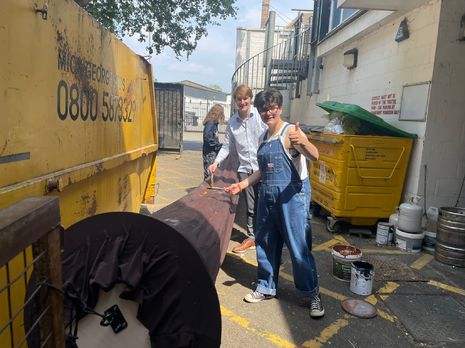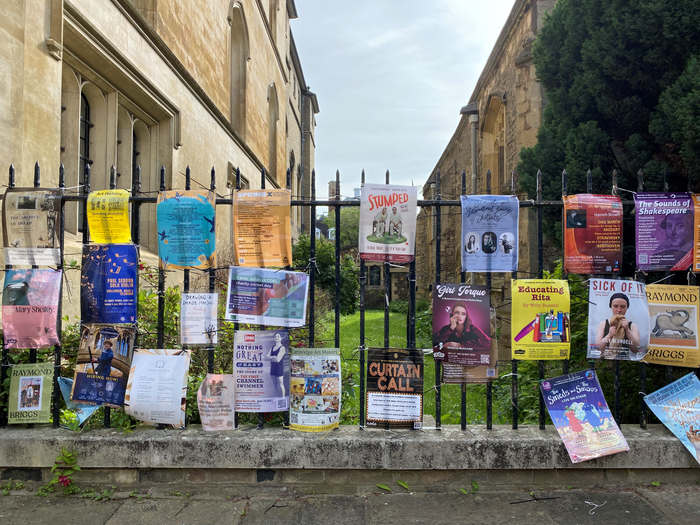Creating the ‘fantastically bizarre’ Mr. Burns, a Post-Electric Play
Learn more about the premise of the play, and the unique design work, from the directors themselves

When we sit down to talk about their production of, Mr. Burns, a Post-Electric Play, directors Emma Gibson and Joshua Robey are brimming with infectious energy. And why wouldn’t they be — the show, which opens on Tuesday at the ADC Theatre, might be one of the most fantastically bizarre you see this year.
Asked to introduce the show to those unfamiliar, Robey tells us it “begins with a group of people who’ve survived some kind of nuclear Armageddon, sitting around a campfire. A bunch of survivors are trying to avoid thinking about the apocalypse by remembering an episode of The Simpsons. The show is all about how this story they remember changes and develops over time, so it’s basically a meeting of cartoon Homer and epic poet Homer.”
“It’s like the cockroach of cartoons. If something survives, it’ll be The Simpsons”
It’s clear that intertextuality is a running theme in the show. Gibson adds that The Simpsons episode, Cape Feare, is based on a movie, which is a remake of another movie of the same name. Act 2 is set seven years later, and follows the group from Act 1 as they tour the country, performing the episode live, for money. Then in Act 3, set 75 years after that, the troupe’s version of Cape Feare has been passed on and has transformed into something very different — an epic opera played with “post-electric” instrumentation.
Taking such a well-known piece of media and putting it in such a radically new light is one of the many bold risks this production takes. The playwright, Anne Washburn, variously considered using Friends, Cheers, or Seinfeld, but decided on The Simpsons for its distinct look and longevity. “It’s like the cockroach of cartoons”, Gibson remarks, “if something survives, it’ll be The Simpsons”.
The directors have been careful to translate the distinct look of the show to the stage. Costume designer Jessi Rogers considered what resources would be available in the seven years after the apocalypse, and how they would contrast with what would be there 75 years after the apocalypse. “For example,” Gibson says, “a lot of the initial costumes in the Act 2 play are made out of fabric, but when the play shifts to 75 years later, the costumes are all made out of rubbish like plastic bags, since that’s what would survive that long”. Robey adds that Rogers has been collecting milk bottle tops from the café where she works for “several months” so she can use them in the show.
“The idea of putting The Simpsons in a post-apocalyptic setting is quite irresistible”
The lighting has also been a major consideration when bringing the show to the stage, given its “post-electric” nature, and the show is lit as if from sources that don’t require mains electricity — sunlight, sunsets, torches, and a campfire. Lighting designers Tungsten Tang and Amelia Cordwell have been finding plenty of innovative ways to achieve this, including rigging up a light that will slowly descend during the first act to represent the sun sinking below the horizon. Last, but not least, there is Rory Clarke’s set design — a forest clearing backed with barbed wire, giving the sense that the characters are on the edge of an exclusion zone.
Putting on a play that incorporates drama, comedy, and music, not to mention huge technical demands sounds like a daunting task immediately post-exams. Robey and Gibson have been passionate about this project long before they pitched it though. Robey mentions that they both had discovered this play independently and thought it was “brilliant”, and they first had the idea of pitching it after working on a production of The Antipodes together in Michaelmas term. Gibson adds that they were inspired by how the show is both “very uplifting” and also “incredibly harrowing in many ways” — a balance which, they add, challenges established ideas about what eco-theatre should be. Plus, the idea of putting The Simpsons in a post-apocalyptic setting is quite irresistible.
According to Robey, audiences can expect “a big laugh, and an even bigger cry.” Gibson adds that they hope people will enjoy the production’s creative approach, and think about the importance of storytelling as something people always turn to in moments of crisis.
The play features spectacular visuals, so the production has teamed up with the Centre for Visual Culture for a pre-show discussion on Thursday 15th June. The panel will discuss in-depth how the play’s visuals work alongside its themes, as well as consider The Simpsons, art, and memory more broadly.
We ask each of the co-directors if they have a favourite (spoiler-free) moment in the play. Gibson says that theirs might be “a bit silly”, but that it’s “all of Act 1”. They especially credit the “unbelievably talented” cast who “do such a great job of going between so many emotional highs and lows.”
Robey, meanwhile, is more secretive. Apart from the cast who are “utterly incredible”, he refuses to say what his answer is because “it’s the very final moment of Act 2!” He does tantalisingly mention that he is “so happy the ADC Theatre has allowed us to keep it.”
You’ll have to come to the show to find out what exactly that moment is.
Mr. Burns, a Post-Electric-Play is playing at the ADC Theatre from Tuesday 13th to Saturday 17th June, 7:45pm
 News / Uni Scout and Guide Club affirms trans inclusion 12 December 2025
News / Uni Scout and Guide Club affirms trans inclusion 12 December 2025 News / Cambridge Vet School gets lifeline year to stay accredited28 November 2025
News / Cambridge Vet School gets lifeline year to stay accredited28 November 2025 Science / Did your ex trip on King’s Parade? The science behind the ‘ick’12 December 2025
Science / Did your ex trip on King’s Parade? The science behind the ‘ick’12 December 2025 News / Cambridge study finds students learn better with notes than AI13 December 2025
News / Cambridge study finds students learn better with notes than AI13 December 2025 News / Pembroke to convert listed office building into accom9 December 2025
News / Pembroke to convert listed office building into accom9 December 2025








